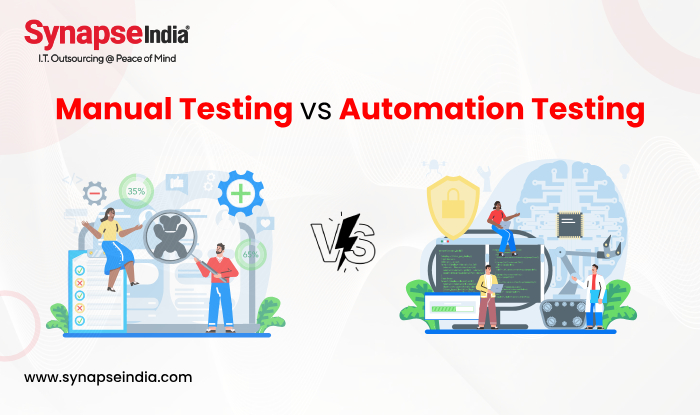Manual Testing vs Automation Testing: Scope, Benefits, and Challenges
 02 Feb 2024
02 Feb 2024
“Manual testing involves humans executing tests on software applications, relying on creativity to find issues. Automation testing uses tools to run tests more efficiently, quickly, and consistently.”

The software development landscape is so vast that it is not easy to choose between manual testing and automation testing. Based on certain factors like efficiency, reliability, and speed of the testing process it is a critical decision that profoundly. Each manual testing and automation testingbrings its own set of advantages and challenges, catering to distinct stages of the software testing lifecycle. Manual testing relies on human intuition and observation, offering a hands-on, exploratory approach, while automation testing leverages scripts and tools to streamline repetitive tasks, enhance precision, and expedite testing cycles. In this blog we will delve into the fundamental differences between manual testing and automation testing, shedding light on their unique characteristics, use cases, and the evolving synergy between the two in modern software development methodologies.
A Brief Comparison Between Manual vs Automation Testing
| Aspect | Manual Testing | Automation Testing |
| Execution | Test cases are executed manually by human testers. | Test cases are executed automatically by testing tools/scripts. |
| Applicability | Suited for exploratory testing, usability testing, and short-term projects. | It is ideal for repetitive tasks, regression testing, and long-term projects. |
| Speed | Slower execution due to manual intervention. | Faster execution, especially for repetitive and large-scale testing. |
| Human Judgment | Relies on human intuition and subjective judgment. | Lacks human intuition; relies on predefined criteria and scripts. |
| Flexibility | Highly flexible, and adaptable to changes and unforeseen scenarios. | Less flexible, better suited for stable applications with fewer changes. |
| Initial Setup Time | Quick to start, minimal setup time. | Initial setup time is required for tool selection, framework development, and script creation. |
| Costs | Lower initial costs, but higher long-term costs due to manual effort. | Higher initial setup costs, but potential long-term cost savings. |
| Exploratory Testing | Highly effective for exploratory and ad-hoc testing. | Not well-suited for exploratory testing, where human creativity is crucial. |
| Regression Testing | Manual regression testing can be time-consuming. | Efficient for quick and consistent regression testing. |
| Adaptability to UI Changes | Adaptable to frequent UI changes. | Fragile to frequent UI changes, requiring script updates. |
| Skill Requirement | Requires domain knowledge and testing expertise. | Requires programming skills and knowledge of testing tools. |
| Scalability | May struggle to scale for large and complex projects. | Well-suited for scalability, especially for large applications. |
| Suitability for Agile | Well-suited for Agile, especially in early development stages. | Complements Agile, but may require continuous script updates. |
1. Manual Testing Scope:
- Exploratory Testing: Manual testers navigate applications, identifying issues and assessing user experiences dynamically.
- Usability Testing: Human testers evaluate interfaces, ensuring the application is user-friendly and aligns with design expectations.
- Ad-hoc Testing:Manual testing adapts to unplanned scenarios, allowing testers to use their expertise and intuition for spontaneous checks.
- Initial Testing Phases: In the project's early stages, when requirements are evolving, manual testing validates functionalities, detecting early defects.
- User Scenario Testing: Effective for testing real-life user scenarios that involve creativity, intuition, and subjective judgment.
2. Automation Testing Scope:
- Repetitive Testing: Automation ensures consistent execution of repetitive test cases, minimizing the risk of human error.
- Regression Testing:Automation quickly runs tests to verify new changes and updates, ensuring existing functionalities are unaffected.
- Large-Scale Data Testing: Efficiently handles large datasets and performs data-driven testing with various input combinations.
- Performance and Load Testing: Automation is vital for simulating heavy loads, and evaluating an application's performance, responsiveness, and scalability.
- Cross-Browser Testing:Automation testing ensures compatibility across multiple browsers and platforms, streamlining the testing process.
3. Manual Testing Benefits:
- Flexibility and Adaptability: Manual testing is highly flexible, making it well-suited for dynamic and evolving projects where frequent changes occur.
- Exploratory Testing: Manual testers can use their intuition and creativity to explore the application, uncovering unexpected issues that automated tests may miss.
- Cost-Effective for Short-Term and Small-Scale Projects:In scenarios with limited resources or projects with short development cycles.
- Effective for User Experience Evaluation: Human testers can provide valuable insights into the user interface, user experience, and overall usability, ensuring the application meets user expectations.
- Ideal for Ad-hoc Testing: Manual testing is adaptable and suitable for ad-hoc testing scenarios, allowing testers to perform unplanned tests based on their experience and intuition.
4. Automation Testing Benefits:
- Efficiency and Speed: Automation testingsignificantly accelerates testing cycles by executing repetitive test cases rapidly.
- Repeatability and Consistency: Automated tests ensure consistent execution, reducing the likelihood of human errors and providing reliable results.
- Regression Testing: Automation is highly effective for regression testing, quickly verifying that new code changes do not adversely impact existing functionalities.
- Large-Scale Data Testing: Automation handles large datasets and performs data-driven testing efficiently.
- Cost Savings in the Long Run: While initial setup costs can be higher, automation testing often results in long-term cost savings.
- Parallel Execution: Automated tests can be run in parallel, enabling simultaneous testing on different environments and configurations, thus saving time.
5. Manual Testing Challenges:
- Time-Consuming for Repetitive Tasks: Manual testing is inherently slower, making it time-consuming for repetitive tasks.
- Subjectivity and Variability: Human testers introduce subjectivity, and results may vary based on individual perspectives.
- Limited Scalability: Manual testing may struggle to scale effectively for large and complex applications.
- Higher Probability of Human Errors: Manual testing is more prone to human errors.
- Costs in the Long Run: While manual testing might seem cost-effective initially.
6. Automation Testing Challenges:
- Initial Setup and Learning Curve: The setup of automation frameworks and the initial creation of test scripts can be time-consuming.
- Not Suitable for Exploratory Testing: Automation is not as effective for exploratory testing.
- Maintenance Overhead: Automated tests require ongoing maintenance to keep up with changes in the application.
- High Initial Costs: While automation can result in long-term cost savings, the initial costs, including testing tools acquisition and training, can be high.
- Limited Adaptability to UI Changes: Automated tests can be fragile in the face of frequent changes to the user interface.
Key Takeaways
In conclusion, the choice between manual testing and automation testing depends on various factors, including project requirements, resources, and long-term goals. Both approaches have their distinct scope, benefits, and challenges. Manual testing remains indispensable, offering a human touch. On the other hand, automation testingproves invaluable for repetitive tasks, large-scale projects, and scenarios where precision and efficiency are paramount. By understanding the scope, benefits, and challenges of both manual and automation testing, teams can make informed decisions that align with their specific project requirements and goals.
Contact Us!
"From the Editor's Desk" is not just about the content. Our content writers will be sharing their thoughts on industry trends, new technologies, and emerging topics that are relevant to our readers. We believe that it's important to stay up-to-date with the latest news and trends, and We excited to share my thoughts and insights with you.
 02 Feb 2024
02 Feb 2024




 26 Mar 2025
26 Mar 2025
